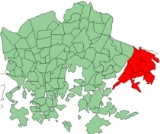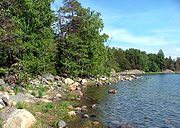
Vuosaari
Encyclopedia
Vuosaari is a neighbourhood in the City of Helsinki
, Finland
. It is located by the sea in East Helsinki
, and with its area of 15.38 km² is geographically the largest district in the city. It also has two Helsinki Metro
stations, Rastila
and Vuosaari
Vuosaari is one of the fastest-growing areas in Helsinki. The number of inhabitants has been increasing rapidly since early 1990s, and continues to grow as new residential areas are being built. Currently (1.1.2006) the number of people living in Vuosaari is 35,000, and it is estimated that by 2010 it will be around 40,000.
Among other things, Vuosaari is noted for its nature and large, relatively unspoilt recreational seashore areas. One of these is Uutela
, a popular nature park located in the southeastern corner of Vuosaari. The continual planning of new residential zones has in fact raised criticism, as many people would rather preserve Vuosaari's closeness to nature.
 Vuosaari is the location of a new major seaport in Helsinki, the Vuosaari Harbour
Vuosaari is the location of a new major seaport in Helsinki, the Vuosaari Harbour
.
As of 2005 7,7% of the population of Vuosaari are foreign citizens and 11,6% have been born outside of Finland. This has given the neighborhood an overtly multi-cultural image in Finnish folklore, even though the percentage is higher in many other places in the Capital Region.
The two natural gas
power plants of Helsingin Energia, the power utility of the city of Helsinki, are located in Vuosaari.
After the war most of the lands in Vuosaari were owned by Oy Saseka Ab, a brick and stone company that had its factory on the island. Big lots of underdeveloped land at a close proximity to the capitol prompted Saseka to start a zoning and building process to increase the value of land there. The Asuntosäästäjät Union (lit. apartment-savers) started to build houses in the sixties, thus creating what colloquially is now known as the Old Vuosaari. Some of Finland's most famous architects participated in the planning, most notably Viljo Revell. Vuosaari was incorporated into Helsinki in 1966.
As the first real influx of refugees and immigrants to Helsinki coincidented with the building of Meri-Rastila in the beginning of the 90s, the quarter quickly became home to an above average population of recent immigrants in Finnish standards. Russians, Estonians and Somalis still form the basis of the immigrant population there - some 11% of the total population. The main street in Meri-Rastila was colloquially renamed to Mogadishu Avenue, which subsequently became the title of a Finnish television series that sought to deal with the intercultural differences between immigrants and native Finns from a comic point of view.
Helsinki
Helsinki is the capital and largest city in Finland. It is in the region of Uusimaa, located in southern Finland, on the shore of the Gulf of Finland, an arm of the Baltic Sea. The population of the city of Helsinki is , making it by far the most populous municipality in Finland. Helsinki is...
, Finland
Finland
Finland , officially the Republic of Finland, is a Nordic country situated in the Fennoscandian region of Northern Europe. It is bordered by Sweden in the west, Norway in the north and Russia in the east, while Estonia lies to its south across the Gulf of Finland.Around 5.4 million people reside...
. It is located by the sea in East Helsinki
East Helsinki
East Helsinki is an area in Helsinki, Finland, usually thought to comprise the city's eastern and south-eastern major districts , including the districts of Vartiokylä, Myllypuro, Mellunkylä, Vuosaari, Herttoniemi, Laajasalo and Kulosaari...
, and with its area of 15.38 km² is geographically the largest district in the city. It also has two Helsinki Metro
Helsinki Metro
The Helsinki Metro , is the metro system in Helsinki, Finland. It is the World's most northern metro system, and currently the only one in Finland. The system was opened to the general public on 2 August 1982 after 27 years of planning...
stations, Rastila
Rastila metro station
Rastila or Rastböle is a ground-level station on the eastern branch of the Helsinki Metro. It serves the residential areas of Meri-Rastila and Rastila in the district of Vuosaari, in East Helsinki....
and Vuosaari
Vuosaari metro station
Vuosaari or Nordsjö is a ground-level station on the southern branch of the Helsinki Metro. It serves the district of Vuosaari in East Helsinki, and is the terminus of the branch....
Vuosaari is one of the fastest-growing areas in Helsinki. The number of inhabitants has been increasing rapidly since early 1990s, and continues to grow as new residential areas are being built. Currently (1.1.2006) the number of people living in Vuosaari is 35,000, and it is estimated that by 2010 it will be around 40,000.
Among other things, Vuosaari is noted for its nature and large, relatively unspoilt recreational seashore areas. One of these is Uutela
Uutela
Uutela is a nature park in Vuosaari, Helsinki, Finland. It is situated by the sea, and attracts visitors from all over the Helsinki capital area.-External links:*...
, a popular nature park located in the southeastern corner of Vuosaari. The continual planning of new residential zones has in fact raised criticism, as many people would rather preserve Vuosaari's closeness to nature.

Vuosaari Harbour
Vuosaari Harbour is a seaport facility in Helsinki, Finland, opened in November 2008....
.
As of 2005 7,7% of the population of Vuosaari are foreign citizens and 11,6% have been born outside of Finland. This has given the neighborhood an overtly multi-cultural image in Finnish folklore, even though the percentage is higher in many other places in the Capital Region.
The two natural gas
Natural gas
Natural gas is a naturally occurring gas mixture consisting primarily of methane, typically with 0–20% higher hydrocarbons . It is found associated with other hydrocarbon fuel, in coal beds, as methane clathrates, and is an important fuel source and a major feedstock for fertilizers.Most natural...
power plants of Helsingin Energia, the power utility of the city of Helsinki, are located in Vuosaari.
History
Vuosaari has been populated continuously ever since the Iron Age. The first written record of the inhabitants of the area comes from a document dating back to Magnus IV of Sweden in the 14th century. By the 16th century Vuosaari had regained its connection to the mainland and the former island had two Rustholl-mansions, Nordsjö and Rastböle respectively, several small villages and a military shipyard. Officers from Suomenlinna built houses in the peninsulas. This process was further amplified after a regular steam boat connection between Helsinki and Vuosaari was established in the 19th century. Of military historical interest is that Russians built fortifications here in 1917. During the Second World War Vuosaari was used as a decoy Helsinki to divert the bombs away from the city. This was done by lighting bonfires and concentrating anti-aircraft guns on the island. Later, during the fast construction phase in the 90's, this led to halts on building sites, as thud aerial bombs were discovered hidden in the ground.After the war most of the lands in Vuosaari were owned by Oy Saseka Ab, a brick and stone company that had its factory on the island. Big lots of underdeveloped land at a close proximity to the capitol prompted Saseka to start a zoning and building process to increase the value of land there. The Asuntosäästäjät Union (lit. apartment-savers) started to build houses in the sixties, thus creating what colloquially is now known as the Old Vuosaari. Some of Finland's most famous architects participated in the planning, most notably Viljo Revell. Vuosaari was incorporated into Helsinki in 1966.
As the first real influx of refugees and immigrants to Helsinki coincidented with the building of Meri-Rastila in the beginning of the 90s, the quarter quickly became home to an above average population of recent immigrants in Finnish standards. Russians, Estonians and Somalis still form the basis of the immigrant population there - some 11% of the total population. The main street in Meri-Rastila was colloquially renamed to Mogadishu Avenue, which subsequently became the title of a Finnish television series that sought to deal with the intercultural differences between immigrants and native Finns from a comic point of view.
External links
- http://www.vuosaari.net/
- http://www.vuosaari.fi/
- Vuosaari at Google Maps (Satellite photos/map)

